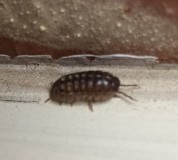Along with the usual insect pest invaders (flies, fleas, mosquitoes and fire ants!), our drought-busting rains have also brought out (or in, as the case may be) some occasional insect visitors.
You are likely seeing millipedes, pillbugs or sowbugs along windowsills and near exterior doors. Millipedes have long, worm-like bodies with a single pair of antenna. Their body is cylindrical and usually brown in color. Millipedes have two pairs of legs per body segment and often curl into a spiral for protection or when they die. They feed on decaying organic matter, though some are carnivorous. These are not to be confused with centipedes, which have longer legs and can sting when threatened. Fortunately, we don’t see many of these in North Texas, especially in urban areas.
Pillbugs usually venture inside during heavy rains. Sowbugs and pillbugs are crustaceans (related to crabs, crayfish and lobsters). They thrive in moist environments and die quickly once they’ve moved indoors due to lack of moisture. Sowbugs and pillbugs have oval shaped bodies, 7 pairs of legs and 2 pair of antennae (only one pair is easily visible). Sowbugs have two tail-like appendages that come off the tip of the abdomen. Pillbugs do not have a tail-like appendage and pillbugs can also roll up into a ball when disturbed (hence the name roly-poly).
If you are having problems with these nuisance pests moving indoors, then you should focus on the outside of the structure to exclude them. Once things dry out then it should go back to normal.
- turn mulch often; adjust watering schedules
- remove any debris laying near structures or areas you do not want pests
- allow air to flow through crawl spaces by using the proper amount of ventilation
- fix any leaking faucets, AC lines, water pipes, etc.
- make sure gutters and drains carry water away from the structure
- make sure doors and windows have a proper seal; replace weather stripping, thresh holds, etc.
- apply sealant to any cracks & crevices and to where pipes or wires penetrate the building
If you are having a mass invasion of pillbugs outside and they are eating your plants (it doesn’t happen too often, but conditions are ripe for this right now), consider treating with a liquid insecticide like permethrin, labeled for garden use. If you have cats, do not use permethrin indoors as this is highly toxic for felines. New plants may need a protective spray every week or so. When treating vegetables, always allow enough time between last application and harvest, according to label instructions. Snail & slug baits containing spinosad and iron phosphate also work on pillbugs and sowbugs. You can also treat with an application of food grade diatomaceous earth as well as sand around your home’s exterior. The DE should be thoroughly mixed in with mulch or soil. This is a gradual treatment and the DE will have to reapplied after rains. Visit us today at Argyle Feed & Hardware— we can help you find the best solution to rid your home and yard of insect invaders!
Source: Texas A & M Agri-Life Extension
